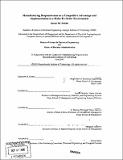| dc.contributor.advisor | Roy E. Welsch. | en_US |
| dc.contributor.author | Smith, Jason M. (Jason Michael) | en_US |
| dc.contributor.other | Leaders for Manufacturing Program. | en_US |
| dc.date.accessioned | 2006-11-08T16:51:33Z | |
| dc.date.available | 2006-11-08T16:51:33Z | |
| dc.date.copyright | 2005 | en_US |
| dc.date.issued | 2005 | en_US |
| dc.identifier.uri | http://hdl.handle.net/1721.1/34864 | |
| dc.description | Thesis (M.B.A.)--Massachusetts Institute of Technology, Sloan School of Management; and, (S.M.)--Massachusetts Institute of Technology, Dept. of Electrical Engineering and Computer Science; in conjunction with the Leaders for Manufacturing Program at MIT, 2005. | en_US |
| dc.description | Includes bibliographical references (p. 65-66). | en_US |
| dc.description.abstract | Many companies have been successful differentiating themselves and creating growth opportunities by developing a competitive advantage through their manufacturing operations. During the last century, this operational advantage has generally included economies of scale and the persistent pursuit of lower direct costs. However, this thesis contends that a cost focused manufacturing organization encourages decisions that in the long run make the organization rigid, inflexible and unable to implement innovations the market desires. Not unexpectedly, those companies that fail to recognize and incorporate changing market demands are relegated to reading about their competitor's successes in newspapers and journals. This thesis further presents an argument to shift the manufacturing organization's operational focus away from cost and towards time. More specifically, this thesis posits that firms should persistently pursue a reduction in the time required to manufacture a customer's order from receipt to shipment. | en_US |
| dc.description.abstract | (cont.) The ideas here are based largely on literature research as well as insights gained during the author's 6.5 month internship at ABB CNTDS. ABB CNTDS is a joint venture manufacturer of power distribution transformers located in Shanghai, P.R. China. Distribution transformers are produced in a make-to-order environment and include significant engineering and customization for each customer's order. The concepts can, however, be extended to any manufacturing organization looking to gain a competitive advantage through speed, innovation, and customer focus - thereby avoiding the undesirable state of low margin, cost competition. | en_US |
| dc.description.statementofresponsibility | by Jason M. Smith. | en_US |
| dc.format.extent | 75 p. | en_US |
| dc.format.extent | 3735991 bytes | |
| dc.format.extent | 3739099 bytes | |
| dc.format.mimetype | application/pdf | |
| dc.format.mimetype | application/pdf | |
| dc.language.iso | eng | en_US |
| dc.publisher | Massachusetts Institute of Technology | en_US |
| dc.rights | M.I.T. theses are protected by copyright. They may be viewed from this source for any purpose, but reproduction or distribution in any format is prohibited without written permission. See provided URL for inquiries about permission. | en_US |
| dc.rights.uri | http://dspace.mit.edu/handle/1721.1/7582 | |
| dc.subject | Sloan School of Management. | en_US |
| dc.subject | Electrical Engineering and Computer Science. | en_US |
| dc.subject | Leaders for Manufacturing Program. | en_US |
| dc.title | Manufacturing responsiveness as a competitive advantage and implementation in a make-to-order environment | en_US |
| dc.type | Thesis | en_US |
| dc.description.degree | S.M. | en_US |
| dc.description.degree | M.B.A. | en_US |
| dc.contributor.department | Leaders for Manufacturing Program at MIT | en_US |
| dc.contributor.department | Massachusetts Institute of Technology. Department of Electrical Engineering and Computer Science | |
| dc.contributor.department | Sloan School of Management | |
| dc.identifier.oclc | 63675967 | en_US |
